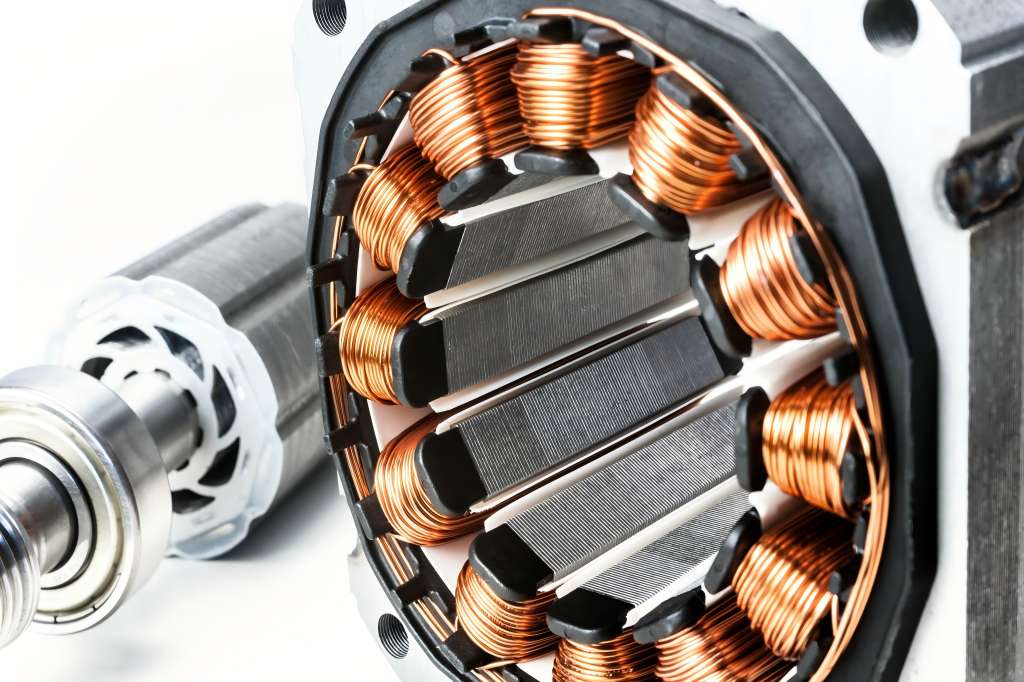Engineers and manufacturers are continually improving motor design to boost efficiency and compactness. One key yet often overlooked factor is the stator slot fill rate, which impacts electrical performance, heat management, and manufacturability.
As electrification expands across EVs, renewable energy, industry, and home appliances, optimizing this metric is vital for modern motor production.
What Is Stator Slot Fill Rate?
The percentage of the stator slot’s cross-sectional area that is made up of conductive winding material—typically copper or aluminum—is known as the stator slot fill rate. Expressed as a percentage, it quantifies how efficiently the slot area is utilized to carry electrical current.
Formula:
Slot Fill Rate (%) = (Total Conductor Area / Total Slot Area) × 100
This metric includes the total area of all conductive wires within the slot but excludes insulation, air gaps, or voids. A higher slot fill rate generally indicates better use of available space for current conduction, which typically leads to improved motor efficiency and power density.
Why Slot Fill Rate Matters
The slot fill rate significantly influences motor characteristics such as torque output, efficiency, thermal performance, and even acoustic behavior. Here’s why it’s considered a key metric in motor manufacturing:
Electrical Efficiency
A higher slot fill rate implies more conductor material per slot, resulting in lower electrical resistance. This reduces I²R (copper) losses, which are among the primary sources of inefficiency in electric motors. For high-performance motors—especially in EVs and servo systems—this translates directly into longer range or better energy savings.
Power and Torque Density
Motors with high slot fill rates can carry more current without overheating, allowing them to generate more torque and output power in a smaller frame size. This is vital in space-constrained applications such as aerospace systems, robotics, and portable equipment.
Thermal Management Challenges
While more conductor material reduces resistance losses, it also restricts space for insulation and impedes heat dissipation. Poorly managed thermal buildup can degrade insulation, reduce lifespan, and in extreme cases, cause motor failure. This makes the slot fill rate a trade-off metric—too low wastes space and performance; too high increases manufacturing and cooling challenges.
Manufacturability
Very high slot fill rates can complicate the winding process. Insertion forces increase, which can damage insulation or deform conductors. Advanced winding methods and better tooling are often required, which increases production cost and complexity.
Typical Slot Fill Rates by Motor Type
Different types of motors and applications target different slot fill rates, depending on their performance and cost priorities.
| Motor Type | Typical Slot Fill Rate (%) |
| Industrial Induction Motors | 30–40% |
| General-Purpose Brushless DC Motors | 35–50% |
| Permanent Magnet Synchronous Motors (PMSM) | 40–60% |
| Hairpin-Wound EV Traction Motors | 50–70% |
| Compact Servo Motors | 45–60% |
| High-Speed Spindle Motors | 25–35% |
Motors with advanced cooling systems or segmented stators can support higher fill rates, as the thermal and mechanical risks are better managed.
How to Increase Slot Fill Rate: Technologies and Methods
Raising the slot fill rate without compromising motor integrity requires precise engineering and advanced manufacturing techniques. Here are the primary ways designers achieve higher fill:
Use of Rectangular (Flat) Wire
Unlike round wire, rectangular or flat wire minimizes air gaps between conductors. Hairpin winding, for instance, uses preformed flat copper bars that fill the slot more effectively, often exceeding 60% fill rates.
Advanced Winding Techniques
Technologies like needle winding, bobbin winding, and wave winding optimize the placement of wire turns to minimize wasted space and allow more conductor material within the same slot dimensions.
Segmented Stator Cores
Instead of a single laminated core, segmented stators consist of multiple tooth segments wound individually and later assembled into a complete core. This method simplifies winding, allows tighter packing, and supports higher fill rates.
Improved Insulation Materials
High-temperature and thin-film insulation materials reduce the space needed between conductors, freeing up more area for copper without sacrificing dielectric strength.
Vacuum Pressure Impregnation (VPI)
VPI techniques enable the insertion of conductive windings followed by the application of resin under vacuum. This reinforces insulation and helps manage thermal expansion, which is critical when fill rates are high.
Trade-Offs and Design Challenges
While aiming for a higher slot fill rate improves electrical performance, it introduces several design trade-offs that manufacturers must navigate:
- Heat Dissipation: Densely packed conductors reduce air flow and cooling effectiveness. Supplementary cooling (like liquid cooling or forced convection) may be required.
- Mechanical Stress: Excessively tight fits can damage conductors during winding or operation due to thermal expansion.
- Cost and Complexity: Achieving fill rates over 50% often requires specialized tooling, tighter tolerances, and skilled labor—all of which increase cost.
- Reliability Concerns: Overfilling slots can lead to insulation breakdown, hot spots, and reduced lifespan if thermal and electrical stresses aren’t properly managed.
Simulation and Digital Twin Tools
With the complexity of optimizing slot fill rate, digital design and simulation have become indispensable in modern motor development.
Key Capabilities Include:
- Electromagnetic Simulation (FEA): Optimizes slot design, tooth geometry, and winding placement for best efficiency.
- Thermal Modeling: Evaluates temperature rise and cooling strategies as fill rate increases.
- Winding Insertion Simulation: Predicts potential mechanical stresses or deformation during the winding process.
Leading motor manufacturers use digital twin models to test multiple stator slot designs virtually before any metal is cut, ensuring optimal performance and manufacturability.
Industry Applications
Electric Vehicles (EVs)
In EV motors, high efficiency and torque density are mission-critical. Manufacturers like Tesla, BMW, and BYD employ hairpin winding with rectangular wire to push slot fill rates beyond 60%. This helps them deliver high-performance motors within compact dimensions.
Industrial Automation
In robotics and CNC machines, servo motors benefit from high slot fill rates to provide rapid acceleration and precision control. Here, segmented cores and needle winding are commonly used to maximize slot efficiency.
Consumer Appliances
In cost-sensitive markets like home appliances, slot fill rate is often optimized for manufacturability and cost rather than maximum performance. A 35–40% fill rate is typical to balance efficiency and affordability.
Renewable Energy Systems
Wind turbine generators and solar-tracking actuators use motors that operate continuously and must be efficient and reliable. Optimizing slot fill rate helps improve energy yield and reduce operational costs.
Emerging Trends in Slot Fill Optimization
Slot fill rate optimization’s future is strongly linked to developments in automation and material science:
Smart Winding Systems
Robotics and AI-powered winding machines are improving consistency and reducing damage during high-fill winding operations.
Enhanced Copper Alloys
Innovations in conductor materials, such as silver-coated copper or nano-coated wire, enable better conductivity even with smaller cross-sections.
Additive Manufacturing
3D-printed stator cores could one day allow more intricate designs with embedded cooling paths, unlocking higher slot fill rates without thermal penalties.
Machine Learning for Design Automation
AI algorithms can analyze thousands of winding configurations and slot geometries, optimizing fill rate alongside other design objectives like torque ripple and noise.
Conclusion
The stator slot fill rate is more than a design detail—it’s essential to creating efficient, compact, high-performance motors. As industries move toward electrification and smaller, lighter machines, optimizing this rate will stay a top priority.
However, boosting the fill rate necessitates striking a balance between cost, mechanical, thermal, and electrical concerns. Achieving this needs advanced design tools, quality materials, precise manufacturing, and strong expertise.



